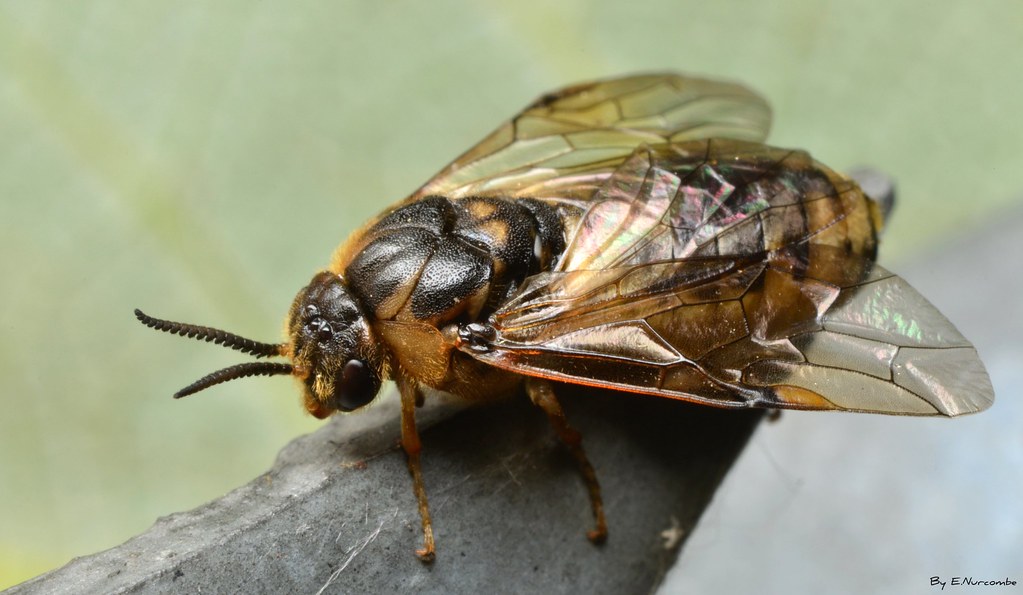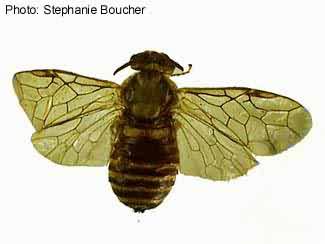Diprionidae
Gilpinia hercyniae
The Buschhorn sawflies ( Diprionidae ) are a family of sawflies ( Symphyta ). Their larvae develop on conifers. Some species are dreaded forest pests. Overall, about 90 species are known.
Features
It is relatively small sawflies (about 5 to 10 mm long). Best detection feature and namesake is the construction of the sensor. These consist of a variable number (14 to 32), short limbs, the ( " cut " ) with the females on the outside of tooth-shaped, wide laminate ( " feathered " or " combed" ) in the males are dilated. The increased sensor surface of the males is used to find the females by pheromones. The males are usually smaller and have more antennal segments than the females. The head is always short. The body is usually relatively compact and stocky, especially the wide end of the fuselage ansitz abdomen is usually also very short. In most other features, the Buschhorn sawflies resemble the genuine sawflies ( Tenthredinidae ) with which they are closely related. Other features relate to the construction of the legs ( hips ( coxae ) of the hind legs touch each other in the middle of the body ) and the Flügelgeäders (radial cell without cross- wire). The wings are crystal clear and usually with striking Flügelmal ( pterostigma ) on the front edge. The ovipositor ( ovipositor ) of the females is relatively short and does not extend beyond the end of the abdomen.
Larvae
The larvae of sawflies Buschhorn similar in body shape caterpillars, they are 17 to 30 mm long. The body is weichhäutig except for a round or oval head capsule. At the top sit very short, tripartite antennas. On the sides of the head sits a larval eye ( Stemma or Ocularium ) with a lens. The labial palps are three -, the four members Maxillarpalpen. The upper lip ( labrum ) is similar to the genuine sawflies, pressed into the middle and asymmetrically shaped mandibles underlying strong are also asymmetrical with right and left different numbers of teeth. On thorax sit three pairs of legs with five members and a large claw. On abdomen sit pseudopods on the segments two to eight, and on the tenth. The body segments are clearly ringed by beads. The larvae of sawflies Buschhorn are often drawn colorful and contrasty. They are, for example, green with white longitudinal stripes ( Gilpinia ) or dark with yellow spots ( Diprion ), the head capsule is light brown or black. The larvae sit freely and without fantasies on their host plants, often in large groups.
Way of life
For all species, the larvae feed on the needles of conifers. Take the Imagines, with the possible exception of a little water or honeydew, no food on. The larvae usually eat at a single tree species ( monophagous ) or genus ( oligophagous ). Depending on the type, these are either pine (Pinus ), spruce (Picea ) or juniper species ( Juniperus ). The larvae appear depending on the type of beginning of May to mid-June, they usually prefer older, last year's needles in a few species the new growth. They grow quite rapidly, with moult between five and seven times. The larvae feed individually, in many species but in large Socialization. When threatened, they take a characteristic "U " shaped shock position. The full-grown larvae can fall to the ground and pupate on the soil surface or in the litter layer, in a rugged, mostly double-walled cocoon the last larval stage spins with his Labialdrüsen. From the cocoons hatch the following spring only part of the larvae. Others about are two or even three years and then hatch until out. Most species have one generation per year, with some species can locally also two generations occur.
Dissemination
All species live in the northern hemisphere in a moderate ( temperate ) or cold ( boreal ) climate. Some types come up in the subtropics before, not in the tropics or in the southern hemisphere.
Economic Importance
Some species are dreaded forest pests that can eat whole forests bare. Defoliation occurs especially in pines ( species: Neodiprion sertifer, Diprion pini, Gilpinia frutetorum ) to, rarely in trees ( especially Gilpinia hercyniae ). Some species have been abducted by humans to areas outside their natural area, such as Gilpinia hercyniae to England and North America. The damage outside the natural range are partly significantly greater than in the origin area. After the introduction of Gilpinia hercyniae biological control was attempted as early as the 1930s, natural antagonists, especially parasitoid Hymenoptera introduce, in an early attempt. In this case, quite a few successes have been achieved, some parasitic wasps species were naturalized and contributed to population limitation in. However, much greater effect had a viral disease that was completely unintentional and initially introduced with breeding material in unnoticed.
System
The Buschhorn sawflies are plant wasps of the superfamily Tenthredinoidea. Probably they are the sister group of the Real sawflies ( Tenthredinidae ). A view sees in them only a subfamily of the Real sawflies.
In Germany, the following species occur:
- Subfamily Monocteninae Monoctenus juniperi ( Linne, 1758). At Juniper, especially in the mountains, the plains rare. Red List 3 (endangered )
- Monoctenus obscuratus ( Hartig, 1837). At Juniper, in the mountains. Possibly synonymous with juniperi. Red List 3 (endangered )
- Macrodiprion nemoralis ( Enslin, 1917). At Scots pine.
- Diprion similis ( Hartig, 1834). At Pine.
- Gilpinia abieticola ( Dalla Torre, 1894). At firs.
- Gilpinia frutetorum (Fabricius, 1793). At pines.
- Gilpinia hercyniae ( Hartig, 1837). At firs.
- Gilpinia laricis ( Jurine, 1807). At Scots pine.
- Gilpinia pallida ( Klug, 1812). At Scots pine.
- Gilpinia polytoma ( Hartig, 1834). At firs.
- Gilpinia socia ( Klug, 1812). At pines.
- Gilpinia variegata ( Hartig, 1834). At Scots pine.
- Gilpinia virens ( Klug, 1812). At Scots pine.
- Neodiprion sertifer ( Geoffroy, 1785 ). At pines.










